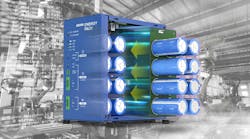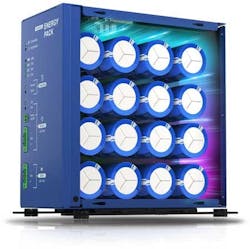This article is part of the Library Series: Rugged Systems.
What you’ll learn:
- How a supercap-based UPS can help in mission-critical applications.
- Why data integrity is essential to mission-critical power management.
As sophisticated as automation processes are, the very nature of rugged computing is defined by environments that are vastly different from a clean, serene data center. Temperatures may be extremely hot or cold (or both), dirt and contaminants are present, and shock and vibration add risk even as systems tap into local sensor data to drive intelligent new processes and capabilities. Most importantly, power streams may be unreliable.
To avoid data loss, data must be captured and processed correctly when a system faces an unexpected power interruption. In these settings, supercapacitors add an essential layer of reliability, sustaining edge computers long enough to save all data during power interruptions and providing power stability during power fluctuations. Paired with rugged edge systems, they fuel uninterrupted power, voltage and current stabilization, power redundancy, and power backup.
Yet even after decades of use and proven engineered value, supercapacitors may still be somewhat misunderstood. As a mature but relatively underrated component, they’re all too often compared to a battery.
In reality, these devices empower significant advances in powerful energy storage. Today, the supercapacitor's ability to safely sustain cycles of high charge and discharge optimizes it for use in challenging automation applications, where energy can be gathered and reused.
Nonstop Performance—Supercapacitors Can Meet Demand at the Rugged Edge
Traditional system batteries, such as lithium ion, haven’t proven to be a safe power source in critical or hostile compute environments common to industrial automation. Think confined or dangerous scenarios in which chemicals, contaminants, and operating temperatures create hazards or strict limitations for battery performance.
Supercapacitors offer a safe alternative in these restricted settings. They power redundancy and backup long enough to properly operate alarms and shutdown processes for mission-critical data processing and management.
Designed to replace a battery-based uninterruptible power supply (UPS), supercapacitors offer similar electrical functions that protect connected devices from data loss due to unexpected power interruptions and fluctuations (see table).
Supercapacitors are designed to replace battery-based uninterruptible power supplies (UPS) and offer similar electrical functions that protect connected devices from data loss due to unexpected power interruptions and fluctuations. Supercaps act like UPS devices, only smarter, adding a voltage and current stabilizer, power redundancy, and power backup as illustrated in this table. (Source: Premio)
Supercapacitor Spotlight: The EDGEBoost EnergyPack
Illustrated by Premio's ECO-1000 EDGEBoost EnergyPack (Fig. 1), the device acts like a UPS, only smarter, adding a voltage and current stabilizer, power redundancy, and power backup. A constant 12- or 24-V current flows, delivering crucial consistency to systems that can’t tolerate power fluctuations resulting in unexpected system shutdown.
Discharge time varies by model, with timed intervals based on the availably of 8X or 16X supercapacitors, depending on how much backup energy storage is required. For example, 8X supercapacitors at 100-W load can provide power redundancy for 12 or 24 V for specific discharge times. A system offering 16X supercapacitors can support up to a 200-W load for a specific discharge time.
Overall, depending on the type of application, a timed discharge is available for power redundancy in environments where real-time data processing and telemetry is most mission-critical.
Mitigating Data Loss Risks in Automation with Supercapacitors
When data integrity is essential, systems operating in a "dirty" power-source environment with constant fluctuations and interruptions benefit from supercapacitor performance. Consider that data flow is crucial to the success of cyber-physical systems (CPS) or those with an ongoing or intensive connection between machines and data.
Simultaneously generating, accessing, and using data in real-time, a CPS is often a closed loop that connects embedded computers, communication networks, and physical sensors to create an autonomous fault-free control system. These systems feature data access and processing as close as possible to their data sources.
Accordingly, such systems are typically constrained by the physical rigors of their working environment, with extreme sensitivity to challenges of latency, bandwidth, and overall reliability. It's a set of characteristics that clearly defines the demand for rugged edge computing—systems purpose-built to process artificial intelligence and machine learning in harsh physical environments.
As industrial settings generate more and more data, smarter data management and access are key to increasing facility automation. This includes a spectrum of applications such as automated inspection of product lines, intelligent security surveillance, biomedical imaging, and vision-guided robotics/vehicles. Costs are reduced and safety is increased, all powered by smarter, real-time data insights based on scalable processing and graphics performance.
With supercapacitors (Fig. 2) added for power redundancy, a camera in a machine-vision application will capture its object detection data properly, even in the event of a catastrophic power failure. A supercapacitor solution can provide stable power for a rugged edge computer to safely shut down, preventing data loss or corruption from immediate power drops.
Supercapacitors Empower Rugged-Edge Computing
Rugged edge computing is all about the data—collected, analyzed, and applied in real-time, no matter the physical demands of the environment at hand. These settings require reliable computers that process and effectively share data between core industrial applications and systems, accelerating deployment of machine learning and intelligent decision-making capabilities.
As computing becomes more edge-native and features decentralization of compute processes, mission-critical power strategies featuring supercapacitors are essential in supporting these data-driven operations.
Read more articles in the Library Series: Rugged Systems.


